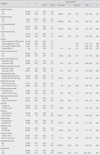Abstract
Purpose
Suicide has been considered a large public health concern in recent years because suicide mortality has been increasing rapidly. This study was done to investigate the prevalence and risk factors of a suicide attempt among adolescents in South Korea.
Methods
The data of the 2006 Youth Health Risk Behavior web-based Survey collected by the Korean Center for Disease Control was analyzed using logistic regression for this study.
Results
The prevalence of a suicide attempt was 5.2% in South Korea. The risk factors of a suicide attempt were suicidal ideation (odds 31.83), depression (odds 7.98), drug use (odds 4.67), currently smoking (odds 3.19), feeling unhappiness (odds 2.77), stress (odds 2.60), currently drinking alcohol (odds 2.39), sexual activity (odds 2.33), living with neither parent (odds 2.24), initial alcohol drinking by age 9 (odds 1.80), health status (odds 2.15), skipped breakfast (odds 1.75), disease (odds 1.65), and school records (odds 1.22).
Figures and Tables
References
1. Cho SJ, Jeon HJ, Kim JK, Suh TW, Kim SU, Hahm BJ, et al. Prevalence of suicide behaviors (suicidal ideation and suicide attempt) and risk factors of suicide attempts in junior and high school adolescents. Journal of Korean Neuropsychiatric Association. 2002. 41:1142–1154.
2. Eaton DK, Kann L, Kinchen S, Ross J, Hawkins J, Harris WA, et al. Youth risk behavior surveillance-United States, 2005. Morbidity and Mortality Weekly Report. 2006. 55(5):1–108.

3. Hong NM, Chung YS. A study of factors influencing suicidal ideation among adolescents. Journal of the Korean Academy of Social Welfare. 1999. 37:449–473.
4. Hong YS, Jeon SY. The effects of life stress and depression for adolescent suicidal ideation. Mental health & Social work. 2005. 19:125–149.
5. Jessor R. Risk behavior in adolescence: A psychosocial frame-work for understanding and action. Journal of Adolescent Health. 1991. 12:597–605.

6. Jessor R. New perspectives on adolescent risk behavior. 1998. Cambridge, England: Cambridge University Press.
7. Kim YT, Lee YK, Kim YJ, Yun PK, Park JY, Jeong SH, et al. The secondary online survey of the health behavior among the adolescents. 2007. Seoul: Korea Center for Disease Control.
8. King RA, Schwab-Stone M, Flisher AJ, Greenwald S, Kramer RA, Goodman SH, et al. Psychosocial and risk behavior correlates of youth suicide attempts and suicidal ideation. Journal of the American Academy of Child and Adolescent Psychiatry. 2001. 40:837–846.

9. Korea Centers for Disease Control and Prevention. Korea Youth Risk Behavior Web-based Survey (raw data). 2006.
10. Korea National Statistical Office. Annual report on the cause of death statistics (Based on vital registration). 2006. Daejeon: Korea National Statistical Office.
11. The cause of death statistics by region. Korea National Statistical Office. 2007. Retrieved December 29, 2007. from http://www.kosis.kr/.
12. Lee CS, Kweon YR, Kim SJ. The impact of school bullying victim and depression on suicidal ideation of middle school students. Journal of Korean Psychiatric and Mental Health Nursing. 2007. 16:32–40.
13. Lee HJ, Kim MH. A path model for self-identity and hopeless to suicidal ideation of college students. Journal of the Korea Youth Research Association. 2007. 14:243–264.
14. Lewinsohn PM, Rohde P, Seeley JR. Adolescent suicidal ideation and attempts: Prevalence, risk factors, and clinical implications. Journal of Clinical Psychology. 1996. 3:25–46.

15. Mcgee R, Williams S, Nada-Raja S. Is cigarette smoking associated with suicidal ideation among young people? The American Journal of Psychiatry. 2005. 162:619–620.

16. Nickel C, Simek M, Moleda A, Muehlbacher M, Buschmann W, Fartacek R, et al. Suicide attempts versus suicidal ideation in bulimic female adolescents. Pediatrics International. 2006. 48:374–381.

17. Park HS, Schepp KG, Jang EH, Koo HY. Predictors of suicidal ideation among high school students by gender in South Korea. Journal of School Health. 2006. 76:181–188.

18. Park JS, Lee JY, Kim SD. A study for effects of economic growth rate and unemployment rate to suicide rate in Korea. The Korean Journal of Preventive Medicine. 2003. 36:85–91.
19. Rey Gex C, Narring F, Ferron C, Michaud PA. Suicide attempts among adolescents in Switzerland: Prevalence, associated factors and comorbidity. Acta Psychiatrica Scandinavica. 1998. 98:23–33.
20. Rohde P, Seeley JS, Rohling J, Rohling M. The life attitudes schedule-short form: Psychometric properties and correlates of adolescent suicide proneness. Suicide and Life-Threatening Behavior. 2003. 33:249–260.

21. Rosenberg HJ, Jankowski MK, Senqupta A, Wolfe RS, Wolford GL, Rosenberg SD. Single and multiple suicide attempts and associated health risk factors in New Hampshire adolescents. Suicide & Life-Threatening Behavior. 2005. 35:547–557.

22. Sanchez HG. Risk factors model for suicide assessment and intervention. Professional Psychology-Research & Practice. 2001. 32:351–358.
23. Sosin DM, Koepsell TD, Rivara FP, Mercy JA. Fighting as a Marker for multiple problem behaviors in adolescents. Journal of Adolescent Health. 1995. 16:209–215.

24. Whetstone LM, Morrissy SL, Cumming DM. Children at risk: The association between perceived weight status and suicidal thoughts and attempts in middle school youth. Journal of School Health. 2007. 77:59–66.

25. White JL. The troubled adolescent. 1989. New York: Pergamon Press.
26. Woods ER, Lin YG, Middleman A, Beckford P, Chase L, Durant RH. The associations of suicide attempts in adolescents. Pediatrics. 1997. 99:791–796.

27. Worley NK. Mental Health Nursing in the Community. 1997. St. Louise, MO: Mosby.




 PDF
PDF ePub
ePub Citation
Citation Print
Print




 XML Download
XML Download